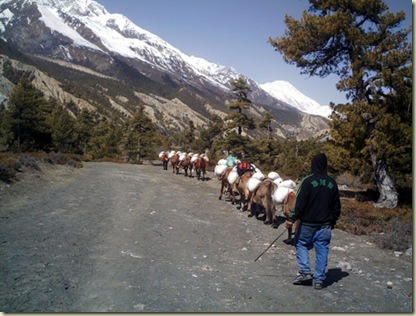In this recent photo mules are driven along a mountain road in Manang district to market against the backdrop of the Annapurna himal. Traditional methods are still used to transport livestock in the region due to lack of motorable roads. (Source: Ekantipur)
Okay, this reminds me of the earlier blog post on trade and the article by Tyler Cowen in the NYT. I know the theoretical stuff in international trade but still I feel something else is missing. So, I want to know how freer trade would help lower food prices for these folks living up in the mountains. Probably, the domestic/local food prices is lower than in the big cities because major foodstuff (except rice) are grown and sold locally. Surplus is taken to nearby market or stored for next season plantation or as buffer against climatic uncertainties.
Varieties of foodstuff not produced locally and are imported to the village from nearby cities cost extremely high. Why? Because transportation cost is much more higher, usually adds up 30% more to the original price of foodstuff. I know the trade theories but still can't figure out where these folks stand out in terms of gains from trade. I feel they are always in the losing side...Are we thinking of the end before giving due attention to intermediate stuff...I mean is it not technically wrong/unwise/unsound to put too much emphasis on trade before giving due attention to the factors that are needed to realize the gains from trade (I am referring to roads, markets, credit, social insurance, governance, etc.)?
